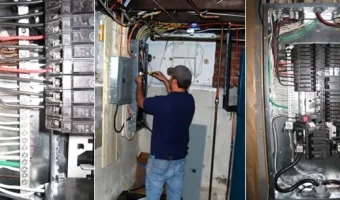Are you feeling the heat but want to keep your energy bills low? Installing a ceiling fan might just be the solution you’re looking for! Not only do ceiling fans help to circulate air and keep your home comfortable, but they can also add a touch of style to any room. If you’ve ever wondered how to go about installing one safely and effectively, you’re in the right place. This guide will walk you through everything from choosing the perfect ceiling fan for your space to ensuring it’s installed correctly. We’ll share tips on finding qualified installation services, what tools you’ll need, and the benefits of hiring a professional when it’s time to boost your home’s airflow. Let’s dive into the world of ceiling fans and discover how they can transform your living environment!
At Turning Point Electric, we provide professional ceiling fan installation services in Spring Hill, FL, ensuring proper electrical wiring and secure mounting to enhance airflow and energy efficiency in your home. Our experienced technicians offer a range of options, including standard, flush mount, Energy Star-rated, smart, and outdoor ceiling fans to meet your specific needs and preferences.
Selecting the right ceiling fan enhances both the functionality and aesthetics of a room. It’s crucial to take multiple factors into account to ensure that your ceiling fan effectively improves air circulation and adds to your home’s style. One of the most important considerations is room size and ceiling height. Room dimensions play a significant role in determining fan size, and having the wrong-sized fan can lead to inefficiencies.
For instance, in rooms up to 75 square feet, a ceiling fan measuring between 29-36 inches in diameter may suffice. However, for larger spaces exceeding 350 square feet, fans should ideally range from 52-60 inches. Here’s a quick reference table to help guide your choice:
Room Size (sq.ft) | Fan Size (inches) |
Up to 75 | 29-36 |
76-144 | 36-42 |
145-225 | 44-50 |
226-400 | 50-54 |
Over 400 | 52-60 |
Additionally, consider your ceiling height; if you have low ceilings, flush mount fans hug the ceiling while still providing adequate airflow. High ceilings may benefit from longer downrods to ensure effective circulation throughout the entire room.
Once you’ve determined the appropriate size for your fan, it’s time to shift gears and think about style and features.
Selecting a ceiling fan that complements your room’s decor can create harmony within the space. Modern fans often feature sleek designs with metal blades that fit contemporary themes, while wooden or antique-style fans seamlessly integrate into traditional interiors. This thoughtful selection works wonders in enhancing your overall aesthetic.
Beyond style, today’s fans come equipped with an array of features that enhance usability and convenience. For example, remote controls eliminate the hassle of reaching for the pull chains when you want to adjust speeds or turn on lights. Dimmable LED lights provide flexibility in brightness—ideal for setting different ambiances according to need. Moreover, reversible motors are invaluable as they allow for year-round use; reversing the motor’s direction redistributes warm air during colder months.
Don’t forget about energy efficiency either! Opting for Energy Star-rated models can significantly reduce consumption without sacrificing performance, making them an environmentally friendly choice that also lowers energy bills over time.
With these considerations in hand—size, style, and features—you’re not only choosing a ceiling fan but enhancing your living environment holistically. The next step involves understanding how to properly install your chosen fan to make sure everything runs perfectly once it is hung proudly overhead.

Glen and his team are amazing. I am a licensed General contractor and have used Turning point on numerous jobs never once have i been disappointed and always beyond satisfied with the value and service . Also Glen and his crew are very nice people.
The first key step in this process is Preparation. Safety should always be your priority, so turn off the power at the circuit breaker to avoid any electrical accidents. Imagine starting a project and realizing you’ve left power flowing — that’s risky and can lead to dangerous situations. Gather all necessary tools beforehand; think about a screwdriver, wire stripper, and a sturdy ladder ready at hand. With everything set up, you create an environment for smooth sailing.
Once prepared, you can move onto the actual mounting.
Next comes Mounting the Bracket, a crucial support structure for your ceiling fan. It’s essential to secure the mounting bracket to the ceiling joist, ensuring it’s firmly fixed. Picture this: if not done right, the entire fan could wobble or even worse, fall down! This bracket supports the fan’s weight and prevents any movement while it operates. If you can’t find a joist, consider using toggle bolts to ensure a secure fit. Attention to detail holds great importance for both function and safety.
Now, for the wiring connections.
Moving on to Wiring Connections, this part may seem daunting, but following instructions makes it manageable. Connect your fan’s wiring to the ceiling wiring as detailed in the fan’s manual — matching colors correctly is key: typically black connects to black (hot wire), white goes to white (neutral), and green or bare copper wires tie into the grounding wire. This connection ensures that your fan operates efficiently without any electrical issues. It’s like solving a puzzle where every piece has its place.
After wiring, it’s time to attach the fan blades.
Once you’ve got those wiring connections sorted out, it’s time for Attaching Fan Blades. Begin fastening each blade to the motor housing securely. While this may appear straightforward, balancing the blades is crucial — an imbalance can lead not only to unsightly wobbling but also wear on motor parts over time. After all blades are connected, take a moment to visually inspect their alignment; a small adjustment can save big headaches later.
Finally, after ensuring all parts are securely fastened and balanced, it’s time to test your newly installed ceiling fan.
Testing involves switching on the power again and observing how smoothly your fan operates, checking that air moves freely without any additional noise or vibrations. Your attention during installation will make this moment rewarding as you enjoy renewed airflow and comfort within your home. Maintenance doesn’t stop here; keeping up with regular checks on fans ensures they remain safe and functional for years to come.
As we shift focus now, let’s consider important factors surrounding electrical systems that are vital for any ceiling fan installation.
The wiring for your ceiling fan is not just a technicality; it’s the backbone of your fan’s functionality and your home’s safety. To ensure everything runs smoothly, both the configuration and quality of the electrical connections must be carefully attended to. Essentially, every detail matters—from selecting the right circuit to making sure that all wires are properly secured and connected.
Start by evaluating the circuit load. Ceiling fans, especially those equipped with lights or additional features like remote controls or smart technology, can draw a considerable amount of power. This means it’s crucial to determine if your existing circuit can handle this demand without overloading.
If your fan draws 80 watts but is on a circuit shared with other devices totaling 1,200 watts, you’re likely safe. However, if combining these loads exceeds 80% of your circuit capacity, it’s time to reconsider. Consider consulting our experienced team at Turning Point Electric in Spring Hill for guidance.
Remember: A well-calculated circuit load will prevent tripped breakers and potential hazards while optimizing performance.
Another vital aspect is grounding. This is essential for preventing electrical shocks, which can occur if there’s a fault in the system. Ensure that the grounding wire is securely connected to both the fan itself and the electrical box where your fan will be mounted. This connection provides a safe pathway for unwanted electricity.
In older homes, you might encounter outdated wiring practices. In such cases, consulting an electrician who can bring your wiring up to current safety standards is wise.
At Turning Point Electric, we recommend performing regular inspections of older wiring systems during installation for added peace of mind.
Beyond load and grounding assessments, make sure that your installation complies with local electrical codes. These regulations are designed to enhance safety and reliability in every electrical installation within your community. Ignoring them may result in fines or unsafe conditions.
It’s always advisable to check with local authorities or professionals like us at Turning Point Electric before commencing any project because what seems straightforward could have hidden complexities.
By grasping these key wiring principles, you’re taking significant strides toward ensuring efficient and safe operation of your ceiling fan—an important foundation as we turn our focus to understanding the necessary tools and equipment for installation.
Installing a ceiling fan may seem daunting at first, but having the proper tools makes all the difference. Think of it as preparing for a culinary adventure; without the right kitchenware, you might struggle to whip up that delicious dish. Here are some essential tools that will help ensure a smooth installation process.
With these tools in your arsenal, you’re all set to move forward with confidence in installing your new ceiling fan!
Investing in high-quality tools might come at a higher initial cost but can save headaches later when installations go smoothly. They often last longer and perform better than cheaper alternatives. Take your time gathering everything—good preparation sets the stage for success!
The right equipment not only enhances the experience but also lays the groundwork for understanding why skilled assistance can make all the difference.
According to satisfied customers from Turning Point Electric, professional installation saves considerable time but guarantees safety and accuracy. Many have expressed relief in knowing that their ceiling fans were handled by trained experts who truly understand the intricacies involved.
One of the foremost concerns for any homeowner is safety. Hiring licensed electricians ensures thorough and secure installation. Certified technicians are trained to make sure all connections are tight and compliant with local building codes. This diligence minimizes risks such as short circuits or even fires, which can stem from improper wiring or inadequate grounding.
Imagine sitting under your newly installed fan without worrying about potential hazards—it’s a peace of mind that is priceless.
Another critical benefit of professional installation is warranty protection. When you opt for professional services, it often comes with a warranty covering both labor and equipment used during the process. This added layer of assurance means that if you encounter issues shortly after the installation—perhaps a flickering light or unexpected noise—repairs will be covered without any surprising charges. It’s this kind of financial security that can make hiring professionals an intelligent investment rather than just an added expense.
In addition to safety and warranties, consider time efficiency. Professional installers complete jobs quickly and smoothly due to their expertise and experience. This doesn’t just mean they get the job done faster; it also reduces the chances of errors that could lead to frustrating setbacks.
Picture this: instead of spending hours poring over installation manuals and troubleshooting issues, you can relax while experts transform your space in record time.
If you’re looking for reliable service in Spring Hill, FL, Turning Point Electric stands ready to provide top-notch professional ceiling fan installation catered to your needs. Visit Turning Point Electric for more information and enjoy a cooler, more comfortable home today!

Turning Point Electric stands out among residential electrical contractors because our level of responsiveness to our customers, our commitment to quality and our insistence on safety is unparalleled.

Turning Point Electric offers a wide range of commercial electrical services from troubleshooting, electrical repair and upgrades to maintenance. Our experience and knowledge also enables us to provide energy saving and lighting solutions.

Our experienced electricians can provide sound advice, service, repair or replacement of your electrical panel and circuit breakers. We also provide whole home surge protection with the best warranty in the business.

Protect your entire electrical system with our Whole Home Surge Protection solutions. Our surge protectors ensure that all your appliances, electronics, and devices remain safe and operational while offering the best warranty in the business..





A short description of your company’s role in the success of the project.